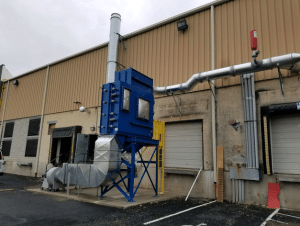
Donaldson Model DFE 4-16 dust collector handling a hybrid mixture pictured with explosion venting and suppression system installed.
Explosion mitigation of combustible dusts is designed around explosion panels, chemical suppression systems and explosion isolation as defined by applicable National Fire Protection Association (NFPA) Standards. When tested, each dust has explosibility values that define how it needs to be handled and what needs to be put in place to comply to the adopted Codes and Standards. These explosibility values often indicate that processes should have a suitable explosion protection system implemented.
Standards Required for a Hybrid Mixture Explosion Protection System
IEP Technologies designs explosion protection systems for combustible dusts that have met NFPA 652 where a Dust Hazard Analysis (DHA) has been conducted so a Kst and Pmax have been determined. Kst (bar-m/s) is a measure in of relative explosion severity compared to other dusts while Pmax (bar) measures the maximum explosion pressure of the dust.
What about those dusts where a Kst has not been defined and is a combination of a dust and a gas? NFPA defines these as hybrid mixtures: “The presence of flammable gases and vapors, even at concentrations less than the lower flammable limit (LFL) of the flammable gases and vapors, adds to the violence of a dust-air combustion.” In certain circumstances, hybrid mixtures can be deflagrable, even if the dust is below the minimum explosion concentration. Furthermore, dusts determined to be non-ignitable by weak ignition sources can sometimes be ignited when part of a hybrid mixture.
Testing these hybrids is oftentimes not possible because the process’s vapor concentration largely fluctuates or a new process is being implemented but in many cases they can be tested if the proper concentrations can be identified and supplied to the testing agency. For Hybrid mixtures that cannot be tested, they are addressed by NFPA 68, “Where test data are not available for hybrid mixtures with gases that have combustible characteristics like those of propane and St-1 and St-2 dusts, the design shall be permitted to be based upon Pmax= 10 bar and Kst = 500 bar-m/s.”
Explosion Protection System for a Hybrid Mixture Dust
SysTech was asked to recommend a system for a Pharmaceutical Filling Suite where a hybrid dust/vapor mixture was being collected. IEP Technologies modeled and provided the design/solution to outfit a Donaldson Model DFE 4-16 Cartridge Dust Collector with four (4) IEP Technologies explosion vent panels to meet NFPA 68 requirements for the Hybrid Application.
The mixture was classified under a Kh value instead of Kst. Kh is measured in the same units of bar-m/s, but it is referring to the relative combustibility of the vapor and dust while Kst only refers to the combustibility of the dust. Due to vapors passing through the filters and being present in both the clean and dirty side of the filtration system, hybrid mixture applications such as this one require explosion vents or panels. Isolation required at the hopper outlet was achieved through mechanical isolation with a rotary airlock manufactured to NFPA Standards 68, 69 and 8503. 7,500 CFM of cleaned air was exhausted to the atmosphere via a ground mounted 30 HP Cincinnati Fan, so ducted return air isolation was not required. The fan had a 70 dBA rated discharge silencer and met AMCA “B” spark resistant construction standards. Chemical inlet isolation was required by NFPA 654, 7.1.3 and was met with an IEP Technologies PistonFire II Suppressor bottle, explosion pressure sensor and an EX-200 Single Zone Control Unit. Installation and ducting was provided to the client by others.
The system is up and running with protection in place! Creating solutions is what we do. Call us at 800-456-9460 and we’ll ensure your explosion protection system is optimized for the protection of your facility and its people.


